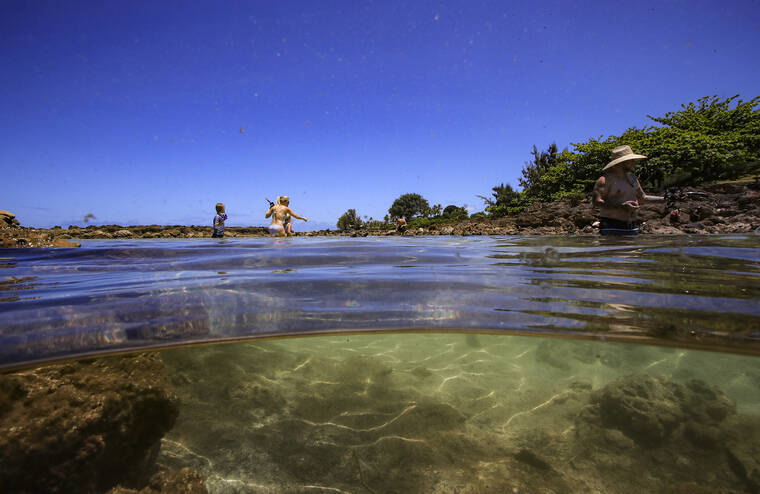Efforts to improve marine conservation receive state funding

JAMM AQUINO / JAQUINO@STARADVERTISER.COM
Visitors enjoy the tidepools on at Shark’s Cove in Pupukea in 2021. The cove is part of the Pupukea Marine Life Conservation District on the North Shore.
State funding is being provided to two ocean-based efforts in Hawaii — one to help conservation in the Pupukea area on Oahu and another to promote fishing statewide.
Senate Bill 3330, signed into law Wednesday by Gov. David Ige, allocates $300,000 in general funds to the Department of Land and Natural Resources for the upcoming fiscal year to study the effect of human activity on the Pupukea Marine Life Conservation District on the North Shore.
The district, which includes the waters at Waimea Bay and Shark’s Cove, is popular for swimming and snorkeling, but heavy traffic in the area could be taking a toll on its coral reefs and fish.
The three-year program will first determine those impacts and will later look at the effect of possible closures and user fees on the recovery of the environment and marine life in the area.
The bill noted that Hanauma Bay Nature Preserve, another popular snorkeling area on Oahu, has an online reservation system, visitor limits, regular closures and fees based on carrying capacity studies.
“I think there’s a lot of this going on, so this project is right on time for an essential marine life conservation district,” said Gil Riviere (D, Heeia-Laie-Waialua), one of the primary authors of SB 3330. “Whatever they’re going to find out, it’s going to be pretty useful.”
Don't miss out on what's happening!
Stay in touch with breaking news, as it happens, conveniently in your email inbox. It's FREE!
Riviere said that geofencing technology, which could designate areas where an online permit or pass would be required, should be explored by DLNR as a possible tool.
A separate measure, Senate Bill 2767, which was also signed by Ige Wednesday, allots $350,000 from state general funds to a program that manages a system of fish aggregation devices in the waters around Hawaii that attract fish.
FADs are anchored buoys that take advantage of the tendency of fish, for a variety of reasons, to aggregate around floating objects. Small or juvenile fish sometimes use FADs for refuge and, in turn, attract larger fish like tuna. As a result, FADs become valuable sites for fishers.
“The FAD program is also an important tool to reduce fishing pressure on Hawaii’s nearshore fishing resources. A lack of funding for the FAD program has decreased the frequency of FAD deployment in recent years,” said Sen. Lorraine Inouye (D, Kaupulehu-Waimea-North Hilo), one of the bill’s introducers.
“The current FADs have a two-year life expectancy. Keeping up on FAD turnover is labor intensive and expensive. Trying to modernize the gear with funding from SB 2767 will allow the FAD program to deploy longer- lasting FADs, which will have approximately a 30% to 50% longer life expectancy than the current FADs.”
The Hawaii Institute of Marine Biology and DLNR manage 55 FADs in Hawaii but reported that they often go missing. In April, 16 of the devices needed to be replaced. Each FAD costs about $12,000 to replace, which the funding from SB 2767 will help cover.



